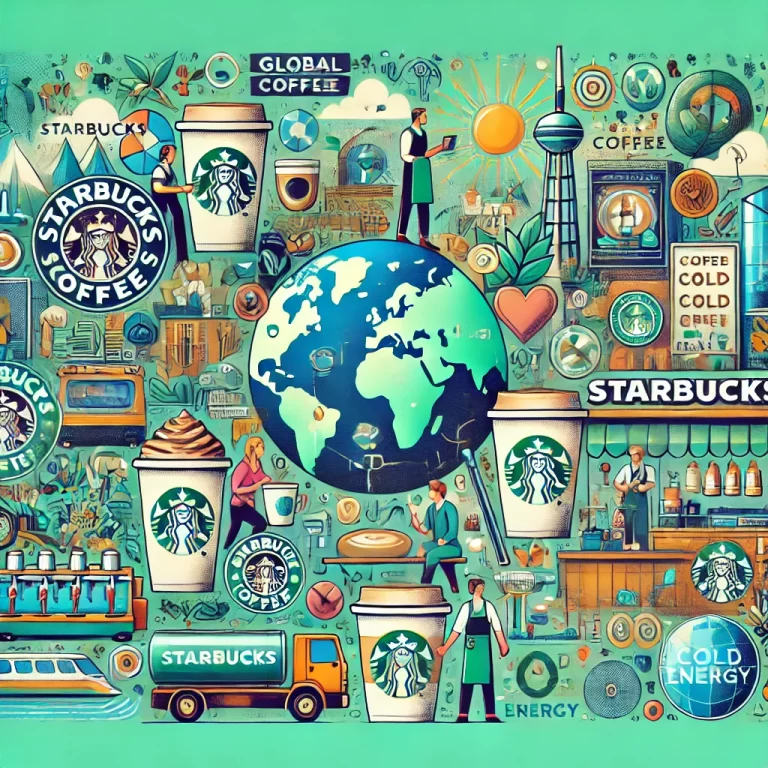Starbucks A Journey of Innovation, Quality, and Global Growth

STARBUCKS – BLACK COFFE ANYONE??
Starbucks is more than just a coffee chain—it is a symbol of the global coffee culture that has evolved over decades. From its humble beginnings in Seattle in 1971 to becoming the world’s largest coffeehouse chain, Starbucks has faced numerous ups and downs while staying committed to quality and innovation. This blog will delve into the history of Starbucks, its challenges, successes, innovations, and financial achievements.
History of Starbucks: From a Single Store to a Global Giant – Starbucks was founded in 1971 by Jerry Baldwin, Zev Siegl, and Gordon Bowker in Seattle, Washington. Initially, the store only sold high-quality coffee beans and equipment for brewing coffee at home. The company was inspired by Alfred Peet, the founder of Peet’s Coffee & Tea, who was known for introducing high-quality coffee beans to the American market. The founders wanted to bring premium coffee to Seattle, focusing on quality over quantity.
WANT TO KNOW WHAT IS YAHOO DOING NOW?
It wasn’t until 1982 that Starbucks began to shift toward the coffeehouse concept that it is now known for. This change came after Howard Schultz joined the company as the Director of Retail Operations and Marketing. On a trip to Italy, Schultz was inspired by the Italian coffee culture and envisioned Starbucks as a place where customers could gather to enjoy high-quality espresso drinks. After some resistance from the original founders, Schultz left Starbucks to start his own coffee chain, Il Giornale, which later acquired Starbucks in 1987 for $3.8 million. Under Schultz’s leadership, Starbucks began expanding rapidly, opening stores outside of Seattle, first in Chicago and Vancouver, and later across the U.S. and internationally.
The Ups and Downs: Challenges Faced by Starbucks
Despite its global success, Starbucks has experienced several challenges throughout its history.
Rapid Expansion and Saturation: During the late 1990s and early 2000s, Starbucks underwent aggressive expansion, opening thousands of stores across the globe. By 2008, Starbucks had grown too fast, with over 16,000 stores worldwide. However, the economic recession hit, and consumer spending slowed. The company was criticized for over-saturating the market, particularly in the U.S., where Starbucks stores could be found on nearly every corner.
LOOKING FOR A TRAINING PROGRAM ON THIS SUBJECT
DEALS THAT YOU CANNOT MISS THIS SEASON
In 2008 Howard Schultz took on the role of CEO again to address decreasing sales, at Starbucks by closing 600 stores in the U.S and reducing expansion efforts to reinvigorate the companys focus on providing top notch coffee experiences to customers. A crucial decision that ultimately brought stability to the business.
As Starbucks grew its presence worldwide it encountered heightened rivalry from coffee brands such, as Dunkin’ Donuts and McCafé well as local cafes and eateries.. Moreover the shift in consumer tastes towards choices and eco initiatives presented a hurdle for Starbucks. Which had built its reputation, on sweetened coffee drinks and calorie laden snacks..
Starbucks responded by adding options to their menu such, as almond and oat milk as plant based milk alternatives and introducing cold beverages like cold brew and nitro coffee that gained popularity with the younger crowd.The company also made a pledge, towards sustainability by opting for sourced coffee beans and ditching plastic straws in favor of eco friendly alternatives.
WANT TO KNOW WHAT IS YAHOO DOING NOW?
Starbucks has always been dedicated to excellence. Right, from the start when they established their brand with an emphasis on quality products and practices that set them apart from the rest of the coffee chains there. They stand out by choosing top grade Arabica beans over the Robusta beans that are commonly used by other cafes. The company works hand in hand with coffee farmers through their C.A.F.E (Coffee and Farmer Equity) initiatives to ensure practices and sustainable farming methods are in place.They place an emphasis on promoting trade and offering organic coffee selections as part of their commitment, to providing high quality products sourced responsibly.
Starbucks puts a lot of effort into training their baristas to guarantee that customers always get top notch coffee no matter which store they visit. Baristas go through training to master the skill of making espresso drinks and pay attention to getting everything just right from grinding the coffee beans to frothing the milk.
Innovation: Keeping Starbucks Ahead – Starbucks’ success can largely be attributed to its commitment to innovation. The company has consistently evolved its menu, digital strategy, and store formats to stay ahead of the competition.
Menu Innovation: Starbucks has a reputation for introducing new and innovative products that often become industry trends. For example, the introduction of the Pumpkin Spice Latte (PSL) in 2003 became a cultural phenomenon, with demand for the drink skyrocketing every autumn. Starbucks has also introduced unique drinks like the Frappuccino (a blended iced coffee beverage), which has been a massive hit with younger consumers.
WANT TO KNOW WHAT IS YAHOO DOING NOW?
To cater to the growing demand for healthier options, Starbucks has expanded its menu to include cold brew, refreshers, and tea-based beverages. The company has also added food options, including breakfast sandwiches, salads, and protein boxes, allowing Starbucks to compete with fast-food chains for the breakfast and lunch markets.
Digital Transformation: Starbucks has been a leader in digital innovation, with a highly successful mobile app that allows customers to order ahead, pay with their phone, and earn rewards through the Starbucks Rewards loyalty program. The app has been a key driver of sales, with mobile orders accounting for nearly 25% of transactions in the U.S. as of 2023.
Starbucks has also integrated its app with voice-activated assistants like Amazon’s Alexa, allowing customers to place orders hands-free. In addition, Starbucks has invested in AI and machine learning to personalize customer experiences, providing tailored product recommendations based on order history and preferences.
WANT TO KNOW WHAT IS YAHOO DOING NOW?
Revenue and Financial Performance – Starbucks is one of the most successful companies in the global food and beverage industry. In 2023, the company reported total revenues of $36 billion, reflecting its continued growth despite challenges posed by inflation and competition.
The company’s business model is a combination of company-owned stores and licensed stores. While most of its stores in the U.S. are company-owned, Starbucks relies on licensing partnerships for international expansion, especially in markets like China, where local partners help operate the stores.
Global Expansion and Store Count: As of 2023, Starbucks operates over 37,000 stores in 84 countries. The company has a significant presence in key international markets like China, where it plans to have over 9,000 stores by 2025. China is Starbucks’ second-largest market after the U.S., contributing significantly to the company’s revenue growth.
Starbucks has also been expanding into smaller store formats, like Starbucks Pickup, designed for customers who order ahead via the app, and drive-thru locations, which have seen increased demand during the COVID-19 pandemic.
WANT TO KNOW WHAT IS YAHOO DOING NOW?
The Future of Starbucks: Sustainability and Growth
Looking ahead, Starbucks is focusing on sustainability and innovation to drive future growth. The company has pledged to become resource-positive by 2030, meaning it aims to give more than it takes from the planet. This includes reducing its carbon footprint, water usage, and waste production through initiatives like recyclable cups and renewable energy.
Starbucks also plans to continue expanding into international markets, with a strong focus on Asia, where demand for premium coffee experiences is growing rapidly. Additionally, the company is exploring new store formats, including drive-thru-only locations and express stores, to meet evolving customer preferences.
Conclusion – Starbucks’ journey from a single coffee store in Seattle to a global coffee powerhouse is a testament to its commitment to quality, innovation, and customer experience. Despite facing challenges such as market saturation and changing consumer preferences, the company has continued to adapt and thrive by embracing digital transformation, expanding its menu offerings, and staying true to its core values of sustainability and ethical sourcing. With a strong financial performance and a focus on future growth, Starbucks is poised to remain a dominant player in the global coffee industry for years to come.

Syed Saif has over two decades of experience in Quality, Excellence, Innovation, Six Sigma, Lean, and Customer Services. He is a Certified Master Black Belt, ISO Lead Auditor, High Impact Trainer, Certified Business Excellence Assessor, Certified on Innovation Business Model Canvas, and holds a PG diploma in Customer Relationship Management. Syed Saif has trained thousands of people, from students to CEOs on various improvement methodologies and self help techniques, and has worked in various industries including BPO, Telecom, IT, Insurance, Manufacturing, and Healthcare. Prior to his full-time consulting role, he served as Vice President for a Leading Insurance Company and as National Head of Quality, Innovation, and Service for Corporate and Sales Functions. See our services page for more details on what we do and how can we help you / your organization.